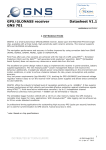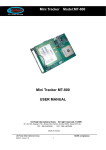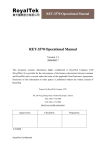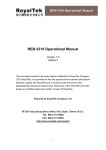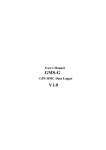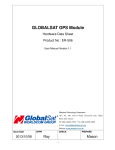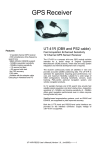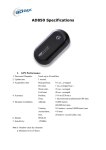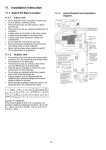Download C:\Documents and Settings\sfasdfasfa\My Documents\My QQ Files
Transcript
SR-92 Manual V1.0 GPS Engine Board Manual SR-92 SIRF STAR Ⅲ V 1.0 Easy to Use Ultra-High Performance GPS Smart Antenna Module With Power Control Made in Taiwan 2008/08/08 [email protected] www.dagamagps.com FREE SERVICE HOT-LINE(FOR MAINLAND):400-820-1322 SR-92 Manual V1.0 Contents 1 2 3 Specifications subject to change without prior notice! Introduction ……….………………………………………………………………..... 1 1.1 1.2 OVERVIEW............................................................................................................ 1 MAIN FEATURES................................................................................................... 1 1.3 1.4 1.5 RECEIVER SPECIFICATIONS...................................................................................2 PROTOCOLS.......................................................................................................... 3 ANTENNA............................................................................................................. 3 Hardware Interface ………………………………………………………………..... 4 2.1 2.2 MODULE DIMENSION........................................................................................... 4 PIN ASSIGNMENT.................................................................................................. 4 2.3 2.4 2.4.1 MODULE PLACEMENT.......................................................................................... 4 POWER SAVING.....................................................................................................5 Power Saving of Trickle Power............................................................................5 2.4.2 2.4.3 2.4.4 Power Saving of Adaptive Trickle Power............................................................ 5 Power Saving of Push To Fix............................................................................... 5 Power Saving of Power Switch............................................................................ 6 Software Interface ………………………….......………………………………………7 3.1 3.2 NMEA OUTPUT MESSAGES................................................................................. 7 GPGGA - GLOBAL POSITIONING SYSTEM FIX DATA...........................................8 3.3 3.4 3.5 3.6 GPGLL - GEOGRAPHIC POSITION - LATITUDE / LONGITUDE............................... 8 GPGSA - GNSS DOP AND ACTIVE SATELLITES..................................................9 GPGSV - GNSS SATELLITES IN VIEW................................................................. 9 GPRMC - RECOMMENDED MINIMUM SPECIFIC GNSS DATA............................ 10 3.7 3.8 GPVTG - COURSE OVER GROUND AND GROUND SPEED................................... 10 GPZDA - SIRF TIMING MESSAGE..................................................................... 11 4 Electrical and Environmental Data ……………………………………………...…. 12 5 Application …………………………………………………………………………..... 13 SR-92 User’s Manual V1.0 1 SR-92 Manual V1.0 1 Introduction 1.1 Overview SR-92 is a low-power, ultra-high performance, easy to use GPS smart antenna module based on SiRF’s third generation single chip. Its low power consumption and high performance enables the adoption of handheld applications. The slim design allows SR-92 to be placed on topside of the housing to have best GPS signal reception. The 5-pin I/O interface is then connected to the main board with either connector or wire soldering. The integrated antenna design helps reduce the RF and EMI issues to minimum. Fast adoption and high yield production becomes possible. The power control feature is very convenient to turn on/off power via GPIO control pin. It’s especially useful in cases such as to turn off power as the user just wants to watch a movie and GPS function is not needed in the PMP case. 1.2 Main Features Not only handheld but also any other GPS applications can share the following major features of SR-92. Easy adoption with best performance Integrated antenna and EMC protection Built-in backup battery allowing hot/warm starts and better performance No external component demand, just connect and use. Minimum RF and EMI efforts Small size of 18 (W) x 21 (L) x 7 (H) (mm) with patch antenna of 18x18x4mm. Fully implementation of ultra-high performance SiRF StarⅢ single chip architecture High tracking sensitivity of -159dBm Low power consumption of 40mA at full tracking Hardware power saving control pin allowing power off GPS via GPIO SR-92 could be arranged at best reception location inside housing Firmware upgradeable for future potential performance enhancements SR-92 User’s Manual V1.0 1 SR-92 Manual V1.0 1.3 Receiver Specifications Features Specifications GPS receiver type Horizontal Position Accuracy 20 channels, L1 frequency, C/A code < 2.5m (Autonomous) < 2.0m (WAAS) (50% 24hr static, -130dBm) Velocity Accuracy <0.01 m/s (speed) <0.01° (heading) (50%@30m/s) Time accuracy 1µs or less TTFF (Time to First Fix) Hot Start: 1s (50%, -130dBm, autonomous) Warm Start: 35s Cold Start: 42s Sensitivity Tracking: –159dBm (Autonomous) Acquisition: -142dBm Measurement data output Update time: 1 second NMEA output protocol: V.3.00 Baud rate: 4800 (default), 9600, 19200, 38400, 57600 bps (8-N-1) Datum: WGS-84 Default: GGA, GSA, RMC, and GSV Max. Altitude Other options: VTG, GLL, ZDA, or SiRF binary <18,000 m Max. Velocity <1,852 km/hr SBAS Support WAAS, EGNOS Dynamics <4g Power consumption 40mA, continuous tracking mode Power supply 3.3V Dimension (single side) 18 (W) x 21 (L) x 7 (H) mm w/ 18x18x4 (mm) patch antenna Operating temperature -40°C ~ +85°C Storage temperature -40°C ~ +125°C SR-92 User’s Manual V1.0 2 SR-92 Manual V1.0 1.4 Protocols Both NMEA and SiRF binary protocols could be supported via serial UART I/O port – RXA/TXA. The default supported protocol is NMEA protocol. 1. Serial communication channel i. No parity, 8-data bit, 1-stop bit (N-8-1) ii. User selectable factory set baudrate among 4800, 9600, 19200, 38400, and 57600 (default 4800) bps. 2. NMEA 0183 Version 3.00 ASCII output 1.5 i. Default GGA (1 sec), GSA (1 sec), GSV (3 sec), RMC (1 sec) ii. Optional VTG, GLL, ZDA Antenna SR-92 has a built-in patch antenna of dimension 18x18x4mm. To have the best performance, we suggest tuning the RF antenna together with product’s outside shell of housing. SR-92 User’s Manual V1.0 3 SR-92 Manual V1.0 2 Hardware Interface 2.1 Module Dimension The dimension of SR-92 is 18 mm (W) x 21 mm (L) x 7 mm (H) with a patch antenna of 18x18x4mm. 2.2 Pin Assignment 4 5-pin Interface Pin 1 Name GND 2 VCC 3 TX Port A serial data output (GPS out); N-8-1, NMEA v3.00 output 4 RX Port A serial data input (GPS in); N-8-1, accepts commands from external applications, e.g. SiRFDemo. Input 5 PWR_CTRL Hardware controlled power saving pin. If this function is used, it is usually connected to a GPIO pin of a micro-processor. “Low”: for normal run “High” or floating: turn off VCC for power saving Tie it to low if this pin is not used. Input 2.3 Ground Function I/O Input Power supply of 3.3 ~ 5.5 VDC Input Output Module Placement The SR-92 module could be placed on any location of your product’s housing that has best signal reception. The 5-pin interface is then connected to your motherboard. There are two items that extrude the bottom PCB plane of SR-92. It may affect the placement of SR-92 into your product’s housing. 1. The antenna is soldered to SR-92 at the bottom via one soldering point. The soldering extrudes the bottom PCB plane of SR-92. It is suggested to reserve a hole of ϕ = 2 mm and depth of 1mm on the under housing. 2. The built-in battery is also soldered to SR-92 at the bottom via two soldering points. The soldering extrudes the bottom PCB plane of SR-92. SR-92 User’s Manual V1.0 4 SR-92 Manual V1.0 2.4 Power Saving SR-92 supports various kinds of power saving mechanisms – Trickle Power, Adaptive Trickle Power, Push To Fix, and power switch. The first three kinds of power saving mechanisms are implemented in software and the power switch mechanism is implemented in hardware. 2.4.1 Power Saving of Trickle Power The trickle power saving mechanism is achieved by switching off and on CPU and RF at a fixed time interval. The biggest time interval to report a position is 10 seconds. The on and off ratio is configurable. This feature is useful for applications that need to report position regularly while power saving is significant. This feature is done by firmware automatically if this feature is enabled. The standard firmware does not turn on this feature. It could be customized by request of MOQ. 2.4.2 Power Saving of Adaptive Trickle Power The adaptive trickle power saving mechanism is basically the same as trickle power saving mechanism with difference that it would not turn the power off if the signal quality is not good enough for tracking. Thus, it keeps both benefits of performance and power saving intelligently. This feature is done by firmware automatically if this feature is enabled. The standard firmware does not turn on this feature. It could be customized by request of MOQ. 2.4.3 Power Saving of Push To Fix The Push To Fix power saving mechanism will not report position data until a specified time interval expires or triggered by external event. Typically, to keep the up to date position data, it would wake up to collect ephemeris and almanac data every 30 minutes. The time interval is also configurable. This mechanism is especially useful for applications that need position data only on demand. This feature is done by firmware automatically if this feature is enabled. The standard firmware does not turn on this feature. It could be customized by request of MOQ. SR-92 User’s Manual V1.0 5 SR-92 Manual V1.0 2.4.4 Power Saving of Power Switch The Power Switch power saving mechanism will turn off not only the CPU and RF but also the whole engine board. In the mean time, the backup battery will start to power GPS’s RTC and internal memory for better performance. The power saving is controlled by the external application via the control pin (PWR_CTRL; pin 5). The engine board will be on if PWR_CTRL pin is low. It would be off if the pin is high or floating. The designer has full control of the power supply status of the smart antenna. The power saving is also more complete. Applications such as PMP navigator may prefer to stop GPS while it just runs movie watching. There might be similar demand for different applications. This mechanism is achieved by hardware and external control of pin PWR_CTRL is required if this mechanism is used. Tie this pin to low if the mechanism is not used. SR-92 User’s Manual V1.0 6 SR-92 Manual V1.0 3 Software Interface 3.1 NMEA Output Messages The NMEA-0183 Output Messages are shown as below: NMEA Record Descriptions GPGGA Global positioning system fixed data: time, position, fixed type GPGLL Geographic position: latitude, longitude, UTC time of position fix and status GPGSA GPS receiver operating mode, active satellites, and DOP values GPGSV GNSS satellites in view: ID number, elevation, azimuth, and SNR values GPRMC Recommended minimum specific GNSS data: time, date, position, course, speed GPVTG Course over ground and ground speed GPZDA PPS timing message (synchronized to PPS) The SR-92 adopts interface protocol of National Marine Electronics Association's NMEA-0183 Version 3.00 interface specification. SR-92 supports 7 types of NMEA sentences (GPGGA, GPGLL, GPGSA, GPGSV, GPRMC, GPVTG, and GPZDA). The default output sentences are GPGGA, GPGSA, GPGSV, and GPRMC. The UART communication parameters are 4800 bps, 8 data bits, 1 stop bit, and no parity. Other output sentences, baud rate, and related configurations could be requested based on MOQ. Single message example $GPGGA,101229.487,3723.2475,N,12158.3416,W,1,07,1.0,9.0,M, , , ,0000*3E $GPGLL,2446.8619,N,12100.2579,E,060725.000,A,A*7E $GPGSA,A,3,05,02,26,27,09,04,15, , , , , ,1.8,1.0,1.5*11 $GPGSV,3,1,12,07,62,081,37,16,61,333,37,01,60,166,37,25,56,053,36*74 $GPGSV,3,2,12,03,43,123,33,23,32,316,34,14,17,152,30,20,16,263,33*78 $GPGSV,3,3,12,19,17,210,29,06,08,040,,15,06,117,27,21,05,092,27*7E $ GPRMC,151229.487,A,3723.2475,N,12148.3416,W,0.13,309.62,120598,,,A*5F $GPVTG,,T,,M,0.00,N,0.0,K,A*13 $GPZDA,060526.000,20,06,2006,,*51 SR-92 User’s Manual V1.0 7 SR-92 Manual V1.0 3.2 GPGGA - Global Positioning System Fix Data Example Explanation $GPGGA,101229.487,3723.2475,N,12158.3416,W,1,07,1.0,9.0,M, , , ,0000*3E Contents Message ID UTC Time Example $GPGGA 101229.487 Latitude 3723.2475 North/South Longitude N 12158.3416 East/West Position Fix Indicator W 1 Satellites Used 07 HDOP MSL Altitude Unit Geoidal separation Units Age of Diff. Corr. Diff. Ref. Station ID checksum <CR><LF> 1.0 9.0 M Unit Explanation GGA protocol header hhmmss.sss hh: hour, mm: minute, ss: second ddmm.mmmm dd: degree, mm.mmmm: minute N: North Latitude, S: South Latitude dddmm.mmmm dd: degree, mm.mmmm: minute E: East Longitude, W: West Longitude 0: Fix not available or invalid, 1: GPS SPS Mode, fix valid, 2: Differential GPS, SPS Mode, fix valid, 3~5: Not supported, 6: Dead Reckoning Mode, fix valid Number of satellites used in positioning calculation (0 to 12) Horizontal Dilution of Precision meters Meters meters M Meters Null fields when DGPS is not used second 0000 *3E End of sentence 3.3 GPGLL - Geographic Position - Latitude / Longitude Example $ GPGLL,2446.8619,N,12100.2579,E,060725.000,A,A*7E Explanation Contents Message ID Latitude North/South Longitude East/West UTC Time Status Mode Indicator checksum <CR><LF> Example $GPGLL 2446.8619 N 12100.2579 E 060725.000 A A *7E Unit Explanation GLL protocol header ddmm.mmmm dd: degree, mm.mmmm: minute N: North Latitude, S: South Latitude dddmm.mmmm dd: degree, mm.mmmm: minute E: East Longitude, W: West Longitude hhmmss.sss hh: hour, mm: minute, ss: second A: Data valid, V: Data invalid A: Autonomous, D: DGPS, E: DR End of sentence SR-92 User’s Manual V1.0 8 SR-92 Manual V1.0 3.4 GPGSA - GNSS DOP and Active Satellites Example $GPGSA,A,3,05,02,26,27,09,04,15, , , , , ,1.8,1.0,1.5*11 Explanation Contents Message ID Mode 1 Example $GPGSA A Mode 2 3 Satellite used in solution Satellite used in solution … PDOP HDOP VDOP checksum <CR><LF> 05 02 1.8 1.0 1.5 *11 Explanation GSA protocol header M: Manual—forced to operate in 2D or 3D mode A: 2D Automatic—allowed to automatically switch 2D/3D 1: Fix not available 2: 2D (< 4 Satellites used) 3: 3D (> 3 Satellite s used) Satellite on Channel 1 Satellite on Channel 2 Display of quantity used (12 max) Position Dilution of Precision Horizontal Dilution of Precision Vertical Dilution of Precision End of sentence 3.5 GPGSV - GNSS Satellites in View Example $GPGSV,2,1,07,07,79,048,42,02,51,062,43,26,36,256,42,27,27,138,42*71 $GPGSV,2,2,07,09,23,313,42,04,19,159,41,15,12,041,42*41 Explanation Contents Message ID Number of messages Message number Satellites in view Satellite ID number Elevation Example $GPGSV 2 1 07 07 79 Unit Azimuth 048 degrees SNR (C/No) 42 dBHz … Satellite ID number Elevation 27 27 degrees Azimuth 138 degrees SNR (C/No) 42 dBHz checksum <CR><LF> *71 Explanation GSV protocol header Range 1 to 3 Range 1 to 3 Number of satellites visible from receiver Channel 1 (Range 1 to 32) Elevation angle of satellite as seen from receiver channel 1 (00 to 90) Satellite azimuth as seen from receiver channel 1 (000 to 359) Received signal level C/No from receiver channel 1 (00 to 99, null when not tracking) degrees Channel 4 (Range 1 to 32) Elevation angle of satellite as seen from receiver channel 4 (00 to 90) Satellite azimuth as seen from receiver channel 4 (000 to 359) Received signal level C/No from receiver channel 4 (00 to 99, null when not tracking) End of sentence SR-92 User’s Manual V1.0 9 SR-92 Manual V1.0 3.6 GPRMC - Recommended Minimum Specific GNSS Data Example $GPRMC,151229.487,A,3723.2475,N,12148.3416,W,0.13,309.62,120598,,,A*5F Explanation Contents Message ID UTC Time Example $GPRMC 151229.487 Status Latitude A 3723.2475 North/South Longitude N 12148.3416 East/West Speed over ground Course over ground W 0.13 309.62 Date 120598 Magnetic variation Mode Indicator checksum Unit knots degrees degrees A *5F <CR><LF> Explanation RMC protocol header hhmmss.sss hh: hour, mm: minute, ss: second A: Data valid, V: Data invalid ddmm.mmmm dd: degree, mm.mmmm: minute N: North Latitude, S: South Latitude dddmm.mmmm dd: degree, mm.mmmm: minute E: East Longitude, W: West Longitude Receiver’s speed Receiver’s direction of travel Moving clockwise starting at due north ddmmyy dd: Day, mm: Month, yy: Year This receiver does not support magnetic declination. All “course over ground” data are geodetic WGS84 directions. A: Autonomous, D: D-GPS, N: Data not valid A: Autonomous M: Manual D: DGPS S: Simulation E: Dead Reckoning N: Data Invalid End of sentence 3.7 GPVTG - Course over Ground and Ground Speed Example $GPVTG,309.62,T,,M,0.18,N,0.5,K,A*0F Explanation Contents Message ID Course over ground Example $GPVTG 309.62 Reference Course over ground Reference Speed over ground Unit Speed over ground Unit Mode Indicator T Unit degrees degrees M 0.18 N 0.5 K A knots km/hr Explanation VTG protocol header Receiver’s direction of travel Moving clockwise starting at due north (geodetic WGS84 directions) True Receiver’s direction of travel Magnetic Measured horizontal speed Knots Measured horizontal speed km/hr A: Autonomous, D: DGPS, E: DR SR-92 User’s Manual V1.0 10 SR-92 Manual V1.0 checksum <CR><LF> *0F End of sentence SR-92 User’s Manual V1.0 11 SR-92 Manual V1.0 3.8 GPZDA - SiRF Timing Message Example $GPZDA,181813,14,10,2006,00,00*4A Explanation Contents Message ID UTC time Example $GPZDA 181813 Day Month Year Local zone hour Local zone minutes checksum <CR><LF> 14 10 2006 00 00 *4F Unit hour minute Explanation ZDA protocol header Either using valid IONO/UTC or estimated from default leap seconds Day according to UTC time (01 to 31) Month according to UTC time (01 to 12) Year according to UTC time (1980 to 2079) Offset from UTC (set to 00) Offset from UTC (set to 00) End of sentence SR-92 User’s Manual V1.0 12 SR-92 Manual V1.0 4 Electrical and Environmental Data Electrical Data Power Supply 3.3 ~ 5.5VDC Power Consumption (w/o antenna) Backup Battery Supply 40mA/average tracking Digital I/O VIH: 2~3.15V, VIL: 0~0.85V VOH: >2.1V, VOL< 0.72V Protocols NMEA (default), SiRF Binary Nominal voltage: 3.0 V Environmental Data Operating temperature -40 ~ 85℃ Storage temperature -40 ~ 125℃ Vibration 5Hz to 500Hz, 5g Shock Half sine 30g/11ms SR-92 User’s Manual V1.0 13 SR-92 Manual V1.0 5 Application To have best performance, it is suggested to place SR-92 at the location of best RF signal reception, say, the upper side of product housing. The motherboard is usually perpendicular to the upper side housing. In this case, just connect the 5-pin to the motherboard via connection wires. Please note that the backup battery is already included in SR-92. You saved the space, charging circuit and related materials. To control the power of SR-92, connect the PWR_CTRL pin to a GPIO of micro-processor. One can pull low it during normal run. To cut off the power of SR-92, pull high or just let it floating. Tie the PWR_CTRL pin to low if the power saving control feature is not needed. All Rights Reserved SR-92 User’s Manual V1.0 14




















